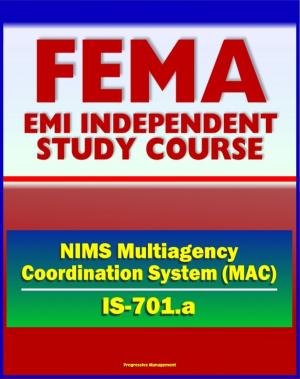21st Century U.S. Military Manuals: Mao Tse-tung on Guerrilla Warfare (Yu Chi Chan) U.S. Marine Corps Reference Publication FMFRP 12-18 (Value-Added Professional Format Series)
Nonfiction, Social & Cultural Studies, Political Science, Government, Communism & Socialism, History, Military| Author: | Progressive Management | ISBN: | 9781465850072 |
| Publisher: | Progressive Management | Publication: | November 4, 2011 |
| Imprint: | Smashwords Edition | Language: | English |
| Author: | Progressive Management |
| ISBN: | 9781465850072 |
| Publisher: | Progressive Management |
| Publication: | November 4, 2011 |
| Imprint: | Smashwords Edition |
| Language: | English |
Part of our value-added professional format series, Mao Tse-tung on Guerrilla Warfare gives the reader a chance to learn about this type of warfare from one who lived and fought as a guerrilla for most of his adult life. It is important to understand his philosophy of guerrilla warfare because it is the basis of today's guerrilla forces. The book was translated and published with an introduction by Samuel B. Griffith, Brigadier General, USMC (Ret.), in 1961. This reference publication is Mao Tse-tung's thoughts and philosophy of guerrilla warfare.
At one end of the spectrum, ranks of electronic boxes buried deep in the earth hungrily consume data and spew out endless tapes. Scientists and engineers confer in air-conditioned offices; missiles are checked by intense men who move about them silently, almost reverently. In forty minutes, countdown begins. At the other end of this spectrum, a tired man wearing a greasy felt hat, a tattered shirt, and soiled shorts is seated, his back against a tree. Barrel pressed between his knees, butt resting on the moist earth between sandaled feet, is a Browning automatic rifle. Hooked to his belt, two dirty canvas sacks—one holding three home-made bombs, the other four magazines loaded with .30-caliber ammunition. Draped around his neck, a sausage-like cloth tube with three days' supply of rice. The man stands, raises a water bottle to his lips, rinses his mouth, spits out the water. He looks about him carefully, corks the bottle, slaps the stock of the Browning three times, pauses, slaps it again twice, and disappears silently into the shadows. In forty minutes, his group of fifteen men will occupy a previously prepared ambush. It is probable that guerrilla war, nationalist and revolutionary in nature, will flare up in one or more of half a dozen countries during the next few years. These outbreaks may not initially be inspired, organized, or led by local Communists; indeed, it is probable that they will not be. But they will receive the moral support and vocal encouragement of international Communism, and where circumstances permit, expert advice and material assistance as well.
This field manual has been converted for accurate flowing-text e-book format reproduction.
As a bonus, this reproduction includes FM-1, The Army Field Manual, a capstone manual containing the vision for the Army - sold separately for $5.99. FM 1 establishes the fundamental principles for employing Landpower. The most important of these are the Army's operational concept and the fundamentals that support it. They form the foundation for all Army doctrine. All Soldiers should understand and internalize them. FM 1 describes the American profession of arms, the Army's place in it, and what it means to be a professional Soldier.
This is a privately authored news service and educational publication of Progressive Management.
Part of our value-added professional format series, Mao Tse-tung on Guerrilla Warfare gives the reader a chance to learn about this type of warfare from one who lived and fought as a guerrilla for most of his adult life. It is important to understand his philosophy of guerrilla warfare because it is the basis of today's guerrilla forces. The book was translated and published with an introduction by Samuel B. Griffith, Brigadier General, USMC (Ret.), in 1961. This reference publication is Mao Tse-tung's thoughts and philosophy of guerrilla warfare.
At one end of the spectrum, ranks of electronic boxes buried deep in the earth hungrily consume data and spew out endless tapes. Scientists and engineers confer in air-conditioned offices; missiles are checked by intense men who move about them silently, almost reverently. In forty minutes, countdown begins. At the other end of this spectrum, a tired man wearing a greasy felt hat, a tattered shirt, and soiled shorts is seated, his back against a tree. Barrel pressed between his knees, butt resting on the moist earth between sandaled feet, is a Browning automatic rifle. Hooked to his belt, two dirty canvas sacks—one holding three home-made bombs, the other four magazines loaded with .30-caliber ammunition. Draped around his neck, a sausage-like cloth tube with three days' supply of rice. The man stands, raises a water bottle to his lips, rinses his mouth, spits out the water. He looks about him carefully, corks the bottle, slaps the stock of the Browning three times, pauses, slaps it again twice, and disappears silently into the shadows. In forty minutes, his group of fifteen men will occupy a previously prepared ambush. It is probable that guerrilla war, nationalist and revolutionary in nature, will flare up in one or more of half a dozen countries during the next few years. These outbreaks may not initially be inspired, organized, or led by local Communists; indeed, it is probable that they will not be. But they will receive the moral support and vocal encouragement of international Communism, and where circumstances permit, expert advice and material assistance as well.
This field manual has been converted for accurate flowing-text e-book format reproduction.
As a bonus, this reproduction includes FM-1, The Army Field Manual, a capstone manual containing the vision for the Army - sold separately for $5.99. FM 1 establishes the fundamental principles for employing Landpower. The most important of these are the Army's operational concept and the fundamentals that support it. They form the foundation for all Army doctrine. All Soldiers should understand and internalize them. FM 1 describes the American profession of arms, the Army's place in it, and what it means to be a professional Soldier.
This is a privately authored news service and educational publication of Progressive Management.















